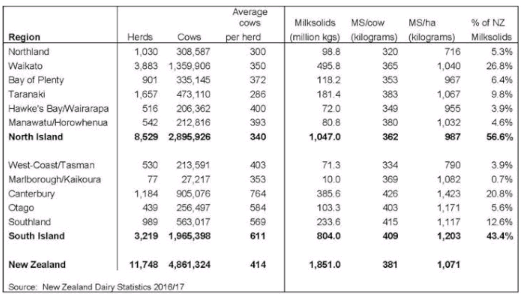



Latest Dairy Stats Reveal More Milk Per Cow, Fewer Cows
NEW ZEALAND - Daisy and her paddock mates are record-breakers, reveal the latest national dairy statistics released today by DairyNZ and LIC.Over the 12 months to June 2017, the average dairy cow produced more litres of milk containing more kilograms of milksolids than ever before.
The average dairy cow produced 4,259 litres of milk in the 2016-17 season, containing a total of 381kg of milksolids (kg MS), compared to 4,185 litres and 372kg MS in 2015-16.
The latest New Zealand Dairy Statistics 2016-17 also reveal milking cow and herd numbers have decreased for the second consecutive year. The latest count is 4.86 million cows nationally – down from 4.99 million in 2015-16 – while herd numbers have dropped to 11,748 from 11,918 (-170 herds).
But despite the decline in cow numbers, dairy companies processed very similar milk quantities – 20.7 billion litres of milk containing 1.85 billion kg MS in 2016-17. The previous season was 20.9 billion litres of milk (1.86 billion kg MS).
The results are positive for New Zealand and its farmers, says DairyNZ and LIC.
DairyNZ senior economist Matthew Newman says the trend for increasing per cow milk production shows farmers are opting for animals that are year-on-year more efficient at converting grass into milk – the industry’s national breeding objective.
"We are producing similar milk quantities from fewer cows, partly because we are breeding better animals and feeding them well," says Mr Newman.
"The average herd is now 414 cows, down from 419 in 2015-16. Currently we are at the lowest level of cows milked since 2012 – with North Island cow numbers declining 90,000 to 2.89 million, while South Island numbers decreased 46,000 to 1.97 million."
LIC general manager NZ Markets, Malcolm Ellis, says the stats reflect a shift in the industry.
"Farmers are acknowledging that, as an industry, if they are not going to be milking more cows then they need to be milking better ones," says Mr Ellis.
"The lower payout in previous seasons certainly forced some farmers to reconsider their cow numbers as part of a wider farm system review, but these stats prove it can really payoff for a farming business.
"It boils down to the fundamentals of herd improvement – creating high quality herd replacements that will out-perform their mothers in productivity, longevity and fertility."
Dairy breeds and artificial breeding
Changes in dairy breeds continue, with Holstein-Friesian/Jersey cross-breeds now comprising 48 per cent of cows (up from 40 per cent in 2010-11). Holstein-Friesians make up 33.5 per cent of the national herd and Jerseys comprise 9.3 per cent.
The number of cows mated by artificial insemination (AI) increased to 72.7 per cent, up slightly on the previous season. The number of yearling heifers mated to AI also increased.
The average six-week in-calf rate decreased 0.9 percentage points to 65.6 per cent in 2016-17 (from 66.5 per cent in 2015-16).
Mr Newman says this decline reflects the difficult spring conditions in 2016, but many farmers will have been focused on improvement in that area for this mating period, particularly with the current milk price.
Sharemilking structure
Farm ownership structures have also changed over the last couple of seasons, with 27.3 per cent of New Zealand dairy herds operating under a sharemilking agreement in 2016-17, compared with 32.4 per cent in 2014-15.
Within the sharemilker herds, variable order sharemilking (VOSM) herd numbers declined in 2016-17. In particular, 20-29 per cent sharemilkers decreased by 235 herds (-29 per cent) to 586. In 2013-14, there were twice as many VOSM herds compared to today (1,357).
Herd-owning sharemilkers (50:50 sharemilkers) declined (-91 herds) for the fourth consecutive season and now account for 19.8 per cent of all herds.
Owner-operator herds increased 188 to 8,503 herds in 2016-17, reflecting VOSMs moving to contract milking after financial challenges with low milk prices.
Quick facts
- The South Island now produces 43.4 per cent of national milksolids, compared with 35.6 per cent a decade ago.
- Milk production in the South Island increased 1.2 per cent in 2015-16, with increases in North Canterbury (+0.8 per cent), Otago (+2.3 per cent) and Southland (+4.9 per cent).
- North Island milk production declined 1.9 per cent in 2016-17, with all regions except Taupo (+2.2 per cent), Taranaki (+0.9 per cent) and Manawatu (no change) producing less milk than in 2015-16.
2016-17 regional dairy statistics

For a copy of the New Zealand Dairy Statistics 2016-17, please click here.
TheCattleSite News Desk


